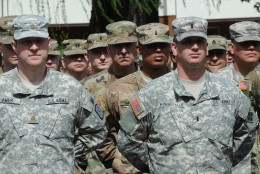
Documentary tells story of WWII’s Black ‘Rosie the Riveters’
A recent documentary tells the story of the black women who streamed into the factories and federal offices in the early 1940s.
Best listening experience is on Chrome, Firefox or Safari. Subscribe to Federal Drive’s daily audio interviews on Apple Podcasts or PodcastOne.
Victory over Japan seems impossibly distant, having occurred now 75 years ago. The mobilization undertaken by the United States to achieve the defeat of Axis powers has been well documented. Most of it, that is. A recent documentary tells the story of the black women who streamed into the factories and federal offices in the early 1940s. Its creator, Gregory Cooke, joined Federal Drive with Tom Temin to discuss.
Interview transcript:
Gregory Cooke: During World War II there were 600,000 African American women who joined the war effort. We know the more so now as Rosie the Riveters, and most people know the iconic image of a white woman with a bandana on and she’s pumping her bicep and over the top it says “we can do it.” Well, in total, they were 5 to 8 million American women of all hues who were Rosies, but one of the things that most people don’t know about is the fact that there were 600,000 African American women who also did that. And you have to understand that prior to World War II, more than 80% of all black women who were employed in this country were either domestics or sharecroppers, those were dead end jobs. If you were a sharecropper, you didn’t even get a check, you didn’t get paid. And if you were a domestic, you were paid very little. So when the war comes along, African American women volunteered, and the doors were open for them to get jobs as heretofore had been close to them. So we had black women who went into factories who built airplanes, who built ships, who built tanks, made ammunition. But we also had black women like my mother who went into federal service in places like Washington, DC. My mother first told me about her life, her experience when I was about four years old, and it made no sense to me. The story goes like this — when my mother was 18 years old, which was 1943. She rode on her suitcase, ON her suitcase, from Norfolk, Virginia, to Washington, DC to get her first job out of high school. She got a job as a clerk typist in the US Patent Office. And she told me that story when I was three or four, she told me that story a couple of times. I think the only reason I remember the story because I had no context and really had no idea what she was talking about. She never mentioned Rosies or World War II, she mentioned her job. And I think the only reason I remembered the story is because it had a train in it. And I’ve had a lifelong love affair with trains. And I think that’s why I remember that story to this day. And as time went on, I came to realize that my mother was actually a historic figure. She did not live to see the work I’m doing, but I know that her and a lot of other women contributed to this country winning World War II, and it’s about time that they get the recognition that they deserve.
Tom Temin: And in your filming of these women, their accounts are really interesting. They entered worlds, factories, federal offices, cities that were just in those days legally segregated. There’s a mention black USO as disticint and seperate from a white USO. And in general, how do they view that experience? The juxtaposition of having this opportunity to do meaningful and exciting work in an exciting time, yet facing segregation that was just rampant and pretty much, deeply entrenched.
Gregory Cooke: Well, you have to remember that was their world. And they knew that segregation meant that they were second class citizens, but that was the world and they had no other point of reference. I talked to one woman and she said that that’s the way it was. It was a part of life and she accepted it. And so everything about America pretty much was segregated. Even in the north you still had segregation. So I’m not sure if it was a great emotional conflict for these women in terms of their patriotism, because they were very patriotic people, and they knew that segregation was wrong, and they knew that they got the short end of the stick. But that is also one of the reasons why they did what they did. They bought war bonds, they had Victory Gardens. World War II was, in my opinion, the only time in American history that virtually every American had some skin in the game. I mean, whether you were black or white, or brown, or whatever you are, you knew somebody or you had someone in your family who in some way or another was involved in World War II, you had 16 million people in the military. So it was hard to find anybody who didn’t have any skin in the game. So all Americans overwhelmingly were pulling in the same direction. We just pulled separately. And one of the things that the African American community use World War II was to continue the fight for civil rights equality, legally equality in American society — and out of that came this campaign called the double V, which was started by the African American newspaper, The Pittsburgh Courier in January 1942, a month after Pearl Harbor. And the whole idea was the slogan was victory over Nazism and fascism overseas and victory over racism at home. So it was a contradiction, but it did not stand in the way of these women who love their country. It did not stand in the way of them contributing in every possible way. And of course, it changed their immediate lives and lives for their families. I’d also like to point out that that 600,000 figure if you were to take and put all 600,000 of those African American women in one city based upon the 1940 census, they would have been the 13th most populous city in America. In my opinion, they were the most significant group of black women in the 20th century. They opened doors of opportunity for all subsequent generations of black women, they brought millions of dollars into the black community during World War II that would not have happened. And it also gave them a greater sense of who they were and what they could do, not only as black women, but as women. They were not paid as much. And they were still this income inequity. The only place you did not have that was in the federal government. If you were a GS-2, everybody got the same pay. Just like in the military, if you are private sergeant, everybody got the same pay. And that did not exist essentially in the private sector. And white women who were Rosies still were paid less than the white men who had those jobs and usually black women, not always, but often black women were actually paid less for the same work that white women were doing. Although the pay they were getting was still a whole lot of money compared to what they would have been making as a domestic or a sharecropper.
Tom Temin: Got it. And you spoke to these women for the film in their late 80s and early or even mid 90s in some case — and what do you feel and what did they tell you was the effect of that work so long ago on their subsequent lives?
Gregory Cooke: Remember now that World War II was really the thing that really kicked America out of the Great Depression. And so these women were children, teenagers during the Great Depression. And so what it did, it gave them skill. For example, Mrs. Ruth Wilson, who lives in Philadelphia, she’s now 98. She helped build an aircraft carrier, the USS Valley Forge, at the Philadelphia Navy Yard. Well, she went to school to be a sheetmetal specialist.That’s not something women did. And so it gave her a lot of confidence in terms of how it set her up for the rest of her life. When Faison on became mayor of Camden, New Jersey at the age of 73. She moved from Clinton, North Carolina, I believe to Camden to New Jersey to work for RCA. It gave her skills. This is a woman who used to pick cotton and strawberries before she walked three miles to school every day, and three miles home. And so all of these women got the skills and this level of confidence that really served them well throughout the rest of their lives. And when I look at their lives, these were phenomenal women who did phenomenal things after the war, and it’s a testament to their courage, to their resilience — but I think all of them acknowledge that World War II gave them a boost, particularly a financial boost that they wouldn’t have gotten.
Copyright © 2025 Federal News Network. All rights reserved. This website is not intended for users located within the European Economic Area.
Tom Temin is host of the Federal Drive and has been providing insight on federal technology and management issues for more than 30 years.
Follow @tteminWFED




